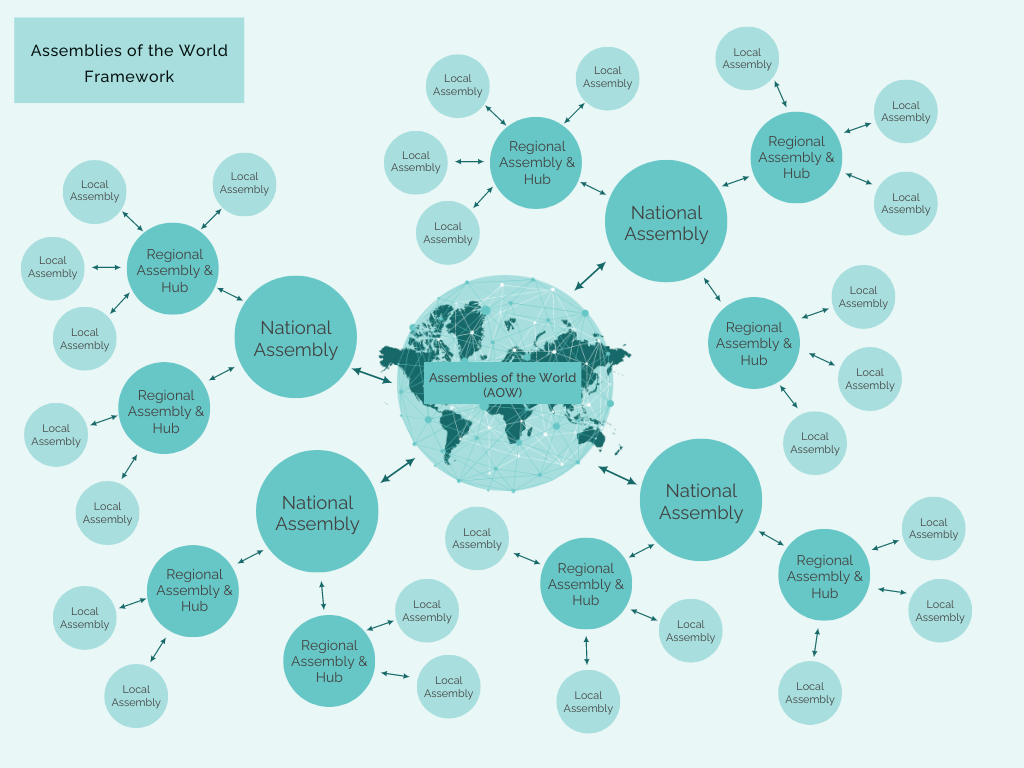Framework Components
The Assembly Framework
The Assembly Framework provides a starting point and is an example. Assembly Frameworks around the world are expected to develop over time according to the wishes of their members.

Local Assemblies bring people together at grass-roots level as Local Assemblies (street, hamlet, village or town) and their associate National Assemblies (county, metropolitan city, area or island). This forms the basis of our Assembly Framework for everyone.
The following descriptions are examples only and reference the
Community Assembly of the British Isles. Other countries may choose a different or modified structure.
International Friends
Individual people who want to become a part of this movement can join through the Community Assembly of the British Isles (CABI) as International Friends.
When the number of International Friends for a given country becomes large enough, the Core Team within CABI will assist in the formation of a National Assembly.
Local Assemblies
Local assemblies are formed by people who live in close proximity. These are the grass-roots assemblies of local people where needs are assessed and decision-making takes place for the benefit and highest good of the community.
They are the direct link to and from the people and are the part of the whole which ultimately influences every decision. Local Assemblies convey the voice and wishes of 'we the people' throughout the network.
Forming a Local Assembly requires a minimum of 3 people to act as facilitators. Facilitators agree to act as liaisons between their individual members and their Regional Assembly. As these roles are voluntary, it is important to ensure that when someone wants to move on, their duties are taken over by a new facilitator.
Regional Assemblies
Regional Assemblies are formed to support groups of local assemblies. Regions are typically defined by the traditional geographical structure of a country.
Forming a Regional Assembly requires a minimum of 3 people to act as facilitators. Regional Assembly Facilitators agree to act as liaisons with all Local Assembly Facilitators. As these roles are voluntary, it is important to ensure that when someone wants to move on, their duties are taken over by a new facilitator.
Assembly Hubs
Assembly Hubs are generally associated with a Regional Assembly. They are physical locations where administrative and other providers can deliver services and support for local assembly members. Administrative functions can include facilities for peace services, courts and occupational training. Services can include organic health, natural healing, spiritual actualisation, child development, project-based learning and creative arts.
National Assemblies
National Assemblies are a team of people who provide administrative support to Regional Assemblies. This team also communicates knowledge and information between Regional Assemblies and Assemblies of the World.
Country Assemblies may choose to form as Private Membership Associations (PAM). When this choice is made, the PAM must conform with that country’s lawful PMA structure.
Forming a National Assembly requires a minimum of 4 people - 3 to act as facilitators with 1 emissary. Each Assembly Emissary maintains a relationship with other emissaries and shares information across the network. As needed, emissaries may have an expanded core team drawn from facilitators, other assembly members and special advisors. As these roles are voluntary, it is important to ensure that when someone wants to move on, their duties are taken over by a new facilitator or emissary.
If you want to go quickly, go alone.
If you want to go far, go together.
African Proverb






